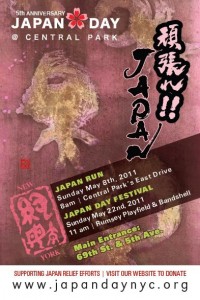JQ Magazine: JQ&A with JET Alum Robert A. Fish, Japan Society’s Director of Education and Lecture Programs
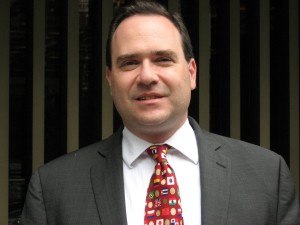
"I applied to the JET Program after three years of high school teaching. The Japanese public education system was held in high esteem at the time and I also felt that I could learn something from the 'gold standard' of educational systems."
By Lyle Sylvander (Yokohama-shi, 2001-02) for JQ magazine. Lyle is entering a master’s program at the School of International and Public Affairs at Columbia University (MIA 2013) and has been writing for the JET Alumni Association since 2004. He is also the goalkeeper for FC Japan, a NYC-based soccer team.
JET alumn Robert Fish (Wakayama-ken, 1996-97) joined New York’s Japan Society in May 2006 as Director of Education and Lecture Programs. Fish previously served as an Assistant Professor of East Asian history at Indiana State University, where he worked extensively with pre-service teachers. Fish earned a BA in History at Yale University, an MA in Educational Administration at New York University, and a Ph.D. in Japanese History at the University of Hawaii at Manoa.
His research focuses on the history of childhood and education in 20th century Japan, and includes a book manuscript near completion about the history of “mixed-blood” orphans in postwar Japan as well as publications regarding the history “textbook controversy” in Japan.
Tell us about your background.
I studied History at Yale University and taught World History East at my secondary school alma mater, Tenafly High School, in Bergen County, New Jersey. At that time, I didn’t have a strong knowledge base in the region and wanted to learn more about Japan, so I applied to the JET Program after three years of high school teaching. Plus, the Japanese public education system was held in high esteem at the time and I also felt that I could learn something from the “gold standard” of educational systems.
I spent one year teaching English in Wakayama and then enrolled in a Ph.D. program in Japanese History at the University of Hawaii, Manoa. After graduating, I saw two strong career possibilities. One was to go back to teaching at secondary schools, and the second was to pursue a path in academia. I chose the academic one and spent a year teaching at Michigan State University and then Indiana State University, where I was on a tenure track.
Why did you leave academia?
I enjoyed teaching, writing and doing research in Japanese history, but I felt that this opportunity allowed me to develop a real passion of mine: to help primary and secondary teachers teach Japanese history and culture.
Tell us about your current job.
The primary goal is to help teachers teach more effectively about Japan at the national level. Secondly, we help children learn directly through social networking—we promote children to children connections between the United States and Japan. Third, we introduce children to Japan through family programming.
Japan Local: Hokkaido e-newsletter
Via AJET June 2011 Newsletter:
For anyone interested in learning about Japan’s northernmost prefecture, HOKKAIDO! The Red Brick Bulletin is an electronic newsletter published by the Hokkaido Government and prepared by the prefectural English language CIR (i.e., JET). Topics range from nature to history, cuisine to tourist attractions, and much much more!
http://www.pref.hokkaido.lg.jp/ss/tsk/akarenga_eng.htm
Justin’s Japan: Loudness, Akiko Yano Perform Rare Concerts in New York
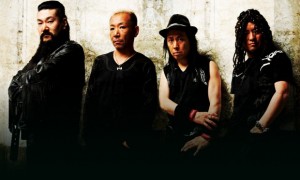
Legendary Japanese metal band Loudness return to Times Square's B.B. King Blues Club & Grill June 1.
By JQ magazine’s Justin Tedaldi (CIR Kobe-shi, 2001-02) for Examiner.com. Visit his page here to subscribe for free alerts on newly published stories.
After their successful tour of Europe last year capped with a headlining gig at Germany’s prestigious Bang Your Head!!! festival, Japan’s Loudness are invading North America for the first time since their sold out 2006 tour, and only the second time since 1991!
Formed in 1981 in Osaka, vocalist Minoru Niihara, guitarist Akira Takasaki (A.K.A. the Eddie Van Halen of Japan), bassist Masayoshi Yamashita and drummer Munetaka Higuchi joined forces to become not only Japan’s premier metal band, but a world class act in their own right, releasing five English-language albums in America in their heyday.
On June 1, the group storms Times Square’s B.B. King Blues Club and Grill, where they last played five years ago in a historic gig filmed for their Loudness in America 06 DVD. (The disc doubles as an epitaph for Higuchi, who succumbed to liver cancer two years later. He was replaced in 2009 by Masayuki Suzuki.)
Metal not your cup of cha? On June 3, Japan Society presents Akiko Yano Solo: Revealing Her Magic. This one-night-only appearance is billed as a concert and talk, exploring renowned singer-songwriter Akiko Yano‘s original music, as influenced and inspired by the unique rhythm and intonation of the Japanese language. In this performance, Yano demonstrates how she bends prose, phrases and salutations into her own musical expressions.
JQ Magazine: JNTO “Meet Japan 2011” Familiarization Trip
 By Gil Cardon (Hiroshima-ken, 2001-04), for JQ magazine. Gil is the convention manager at the Japan National Tourism Organization in New York. He is the primary contact for promoting Japan MICE (Meetings, Incentives, Conventions, and Exhibitions) within North America.
By Gil Cardon (Hiroshima-ken, 2001-04), for JQ magazine. Gil is the convention manager at the Japan National Tourism Organization in New York. He is the primary contact for promoting Japan MICE (Meetings, Incentives, Conventions, and Exhibitions) within North America.
Every year at about the same time, the Japan National Tourism Organization hosts the “Meet Japan” familiarization trip. This year, ten guests from six different countries (U.K., France, Italy, Greece, Israel, and the U.S.) participated in the trip.
The guests are representatives of international organizations and professional associations that are planning to hold a conference in Japan in the near future. Through the course of the Meet Japan trip, the representatives visit convention centers and hotels in various cities throughout Japan, as part of a study tour to learn about the many amenities that the venues have to offer. Participants also have the chance to visit “unique venues” for holding their conferences, such as traditional Japanese ryokans, historic castles, museums, and Noh theaters.
As a representative of the Japan Convention Bureau from the New York office, I had the fortunate opportunity to join the Chiba-Nagoya tour of the 2011 Meet Japan trip, from February 25–March 1, 2011. I had never been to Nagoya before, so I was looking forward to checking it out. I had been to Chiba once before, but I was sure that I would learn something new on this trip.
Video: Anti-nuclear protest march in Tokyo – by JET alum Tom Baker
The meltdown crisis at the tsunami-hit nuclear power plant in Fukushima Prefecture has inspired a number of antinuclear protests in Japan. Journalist and JET alum Tom Baker (Chiba, 1989-1991), who blogs at Tokyo Tom Baker made this video of one that took place in Ginza, Tokyo, last night (May 27):
X Japan’s Yoshiki Takes Manhattan, Meets JET Alums
On May 23, X Japan mainman Yoshiki–who is widely regarded as Japan’s premier rock musician–was in New York City to promote his weekly “Yoshiki Radio” show, which launches on SiriusXM’s Boneyard (channel 38) tonight at 8:00 p.m.
Fujisankei (FCI) News was there, and they interviewed JET alumni Sam Frank of UnRatedNYC and JQ magazine editor/Japanese Culture Examiner Justin Tedaldi for their “Today’s Eye” segment broadcasted on Japanese TV! Check out the video below for Justin’s comments. (Direct link at http://www.fujisankei.com/video_library/art/yoshiki-radio.html)
http://www.youtube.com/watch?v=DXBU4JE8C4o
JetWit Fashion Beat: T-shitsu – The Black Collection
JetWit Fashion Beat is brought to you by Dipika Soni (Ishikawa-ken, 2003-06). Dipika has recently moved back to London as is currently looking for new work opportunities related to Japan, translation, or other fields. She is also the former vocalist for the Japanese hardcore punk band DEGRADE.
——————————————————————————————————————————–
I first posted about T-shitsu and their fantastic designs aimed especially for gai-jin in December last year. Since then the response from members of the JET and JET alum community has been very positive, and the base of returning customers is constantly growing.
This is completely down to the unique omoshiroi designs, high-quality shirts and general high standard of service provided by the T-shitsu team. I can’t rave about these shirts enough!
Currently, our friends at T-shitsu.com are half way through revealing their eagerly anticipated Black Collection.
The Black Collection consists of 8 new designs, one of which is revealed every Sunday, May through June, and we have been given an exclusive sneak preview of this week’s new design especially for JETWit readers….
Ta da!!!
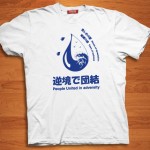 To update you on other recent activities, T-shitsu were very active in wake of the Tohoku eathquake/tsunami disaster in terms of fundraising and encouraging donations. They even designed their own t-shirt to raise money and awareness, called Tohoku Tears, a wonderful design that was distributed through their partner website at Sweatshop Union.
To update you on other recent activities, T-shitsu were very active in wake of the Tohoku eathquake/tsunami disaster in terms of fundraising and encouraging donations. They even designed their own t-shirt to raise money and awareness, called Tohoku Tears, a wonderful design that was distributed through their partner website at Sweatshop Union.
The Tokoku Tears shirt was extremely popular and all shirts sold out in A WEEK! In total the shirt raised an outstanding 300,000 yen. Since then all other designs in the ‘rebuild’ collection have also sold out, but if there are plans to re-release them we will be sure to let you know.
There will be further new releases on T-shitsu.com once The Black Collection finishes, and present designs will be made available in a wider selection of colours. There will also be further promotions and competitions, all of which will be advertised through the T-shitsu Facebook site. Make sure you sign up for all the latest info, and it’s also a great way to contact the designers with your feedback and suggestions for shirts.
Please do post any comments/suggestions about the shirts, in particular any JET-related shirt ideas, and please do inform the T-shitsu team that you heard about them through JETWit if you place any orders. Check back for more updates soon!
Have a suggestion for a future JetWit Fashion Beat post? E-mail dipika [at] jetwit.com.
JQ Magazine: JQ&A with JETAA Country Representative Megan Miller Yoo

“I can’t ever say this enough, but working with the JETAANY executive committee has been an amazing experience. We have such a great team of dedicated volunteers who really want to see the organization succeed and will go to great lengths to make sure that happens.” (Katharine Andriotis)
By Renay Loper (Iwate-ken, 2006-07) for JQ magazine. Renay is a freelance writer and international education professional currently seeking FT opportunities. Visit her blog at Atlas in Her Hand.
Philadelphia native and current Long Island City, NY resident (by way of Hyogo-ken and Washington, D.C.), Megan Miller-Yoo (Hyogo-ken ALT, 2000-02) is the outgoing president of JETAANY (2008-11) and new JETAA USA Country Representative (CR). During her time as an ALT, Megan demonstrated her commitment to the JET Program via her creation of the Volunteer Special Interest Group (VSIG) for AJET.
Since returning to the U.S., Megan has been involved in the Washington D.C., Philadelphia, and New York chapters of JETAA. Megan also served on the Board of Directors for JETAANY. She recently graduated from NYU with her MBA, currently works as an engineering underwriter, AVP with Swiss Re and lives in Long Island City with her husband.
Megan recently spoke with us to share more about her time as JETAANY president, and her new role of CR.
Where did you spend your JET years?
I was an ALT in Hyogo-ken from 2000-02. I worked in the suburbs of Akashi (home of the world’s longest suspension bridge and famous for its tako), which is along the coast between Kobe and Himeji.
You recently finished your third term as JETAANY’s president. How did you get involved with JETAANY?
I moved to New York in November 2005, on the day of the New York City Marathon, which made navigating my U-Haul truck through the city pretty awful. After a year in the city I still did not have a strong network, so I researched JETAANY and showed up at a quarterly meeting being held at Two Boots pizza in early 2007. I was hooked right away and with impending officer elections, Kat Barnas convinced me that very night to take over her spot as vice president. I served as VP from 2007-08 and then moved into the president role for the next three years.
During your tenure, what brought you the most joy?
I can’t ever say this enough, but working with the JETAANY executive committee has been an amazing experience. We have such a great team of dedicated volunteers who really want to see the organization succeed and will go to great lengths to make sure that happens. When you consider that we all have full-time jobs but everyone finds time to make JETAANY events the same caliber as something you’d pay to have done, you start to understand the impact that Japan had on us and how eager we are to give back.
What do you hope your JETAANY legacy will be?
During my tenure I strove to ensure that we delivered high caliber events and benefits to our member base. From the upgraded format of the e-mail announcements and website to the diversity and quality of events, I encouraged everyone involved in the organization to really give it their all and do the best job they could. I believe that people have started to realize what JET alums are capable of and what the value of our network is to Japan, to our home countries, and also to us as members of the network. We are a group of diverse, talented professionals who can really make an impact wherever we choose to focus our efforts, and my goal was to showcase that in everything we did.
How did you go about becoming a CR? What made you make the switch? Read More
Justin’s Japan: Interview with Inuyama City Councilman/JET Alum Anthony Bianchi
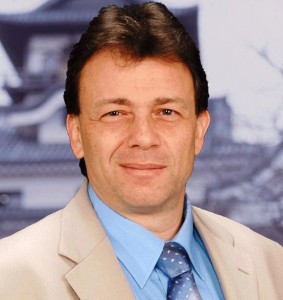
- “The JET Program has great benefits for the country. One of the greatest, but overlooked is the former participants themselves. They all have a great knowledge, understanding and affection for Japan. All have gone on to various careers and are a great but underutilized network.”
By JQ magazine editor Justin Tedaldi (CIR Kobe-shi, 2001-02) for Examiner.com. Visit his page here to subscribe for free alerts on newly published stories.
Anthony Bianchi’s life in Japan took root in the 1980s when the Bensonhurst, Brooklyn native landed a job with the Inuyama City board of education in Aichi Prefecture on the JET Program exchange initiative. He continued to work in Inuyama after JET, and in 2003 gained citizenship, becoming the first-ever North American to hold an elected position in Japan.
In 2006, Bianchi ran for mayor of Inuyama, receiving enough votes to finish third out of eight candidates. He was re-elected to city council in 2007 and started his third term in April. Following a benefit concert for Japan at his alma mater Xaverian High School on March 31, I caught up with the politico in this exclusive interview.
What’s changed for you since you last spoke with JETAA NY in 2008?
I was just reelected for a third term. There are now only four council members with more years on the council than I. That changes the dynamics a bit. How much so we will find out over the next few years. Other than that, local front burner issues have changed, but the job stays pretty much the same. That being said, of course the earthquake and tsunami have changed the country. As a council member in a municipality that was not directly affected, we have to keep in mind what we can do to contribute to the recovery while maintaining necessary levels of service for the people of the city.
How has the election of the Democratic Party of Japan in 2009 changed the way you and your colleagues work in Inuyama?
Unfortunately, not very much. They have been mostly unable to implement their manifest. Due to that they have been soundly defeated in local elections. Keep in mind that the recent local elections were the first since the DPJ took power. The significance of that is that most localities still had a pre-DPJ administration makeup. So they have even less local influence now than they had before they took power. Unless there is a dramatic change in the way they govern, they will loss power in the next lower house elections. A tremendous chance to make significant change has been squandered. What the aftermath will be remains to be seen, but I am afraid it will not be good.
How has the election of President Obama changed any impressions or attitudes of the average Japanese citizen?
Of course, the election of Mr. Obama was watched with great interest here and welcomed. For lack of a better description, it was seen as America becoming a more forward thinking, open and kinder society. You must remember that just as Americans are not cognizant of Japanese political national and domestic issues, so are Japanese not cognizant of America’s. That being the case, President Obama’s election was viewed for its social implications by the Japanese.
What are some of the biggest changes in the JET Program that you’ve observed over the years? Do you work with any JETs?
I sometime talk to those who administrate the program or former participants, but it has been a long time since I was a JET. I really don’t know what things are like on an everyday basis for current participants, and there are no JETs in Inuyama.
In Inuyama I started a program based partly on my JET experience. It is called the Native English Teacher (NET) Program. I started and ran it for seven years before leaving to run for office. The program continues to this day and has six teachers all directly employed by the city. The teachers here must have some ESL qualification. Currently, all teach their own classes based on original materials created by the group.
Although we had some tough going in the first few years, the participants here are pretty much accepted as regular teaching staff at their schools.
Tokyo has mulled budget cuts for the program that may threaten its existence. What are some of the positive effects of JET that you can share with your colleagues in local government to help quantify its value?
I think the program did not get proper considerations during its evaluation by the oversight committee. Although I think JET could use some retooling and needs to redefine its goals, the program has great benefits for the country. One of the greatest, but overlooked is the former participants themselves. They all have a great knowledge, understanding and affection for Japan. All have gone on to various careers and are a great but underutilized network.
For the complete interview, click here.
JETAA British Columbia Newsletter – May 2011
The JETAA British Columbia Newsletter May 2011 issue is now available online. (Really nice look and layout, by the way.)
It also has some very good articles, reactions and perspectives on the Tohoku earthquake/tsunami and subsequent relief efforts and activities by JETs and alumni.
For more info on JETAA BC (which is hosting this year’s JETAA Canada Conference in June), go to their website at www.jetaabc.ca
Justin’s Japan: Japan Day @ Central Park Hosts Music Stars from Keiko Matsui to D.M.C.
By JQ magazine editor Justin Tedaldi (CIR Kobe-shi, 2001-02) for Examiner.com. Visit his page here to subscribe for free alerts on newly published stories.
Now in its fifth year, the upcoming edition of Japan Day @ Central Park on Sunday (May 22nd) will feature a galvanizing stage performance with other family-friendly activities under the theme ”Ganbare Japan!” (You can do it, Japan!) in light of the devastating earthquake and tsunami that occurred in March.
After holding its traditional four-mile Japan Run on May 8, this year’s Japan Day Festival at Rumsey Playfield will feature stage performances and activity tents. Its special guests, introduced in three distinctly-themed acts over seven full hours, will include Circus, Senri Oe, Darryl “D.M.C.” McDaniels (of New York hip-hop legends Run-D.M.C.), AISHA, Keiko Matsui, Mai Fukui, Yuka Takara, Lainie Sakakura, and TEN-YOU. Co-hosting the event are Sandra Endo, a national correspondent for CNN Newsource and NY1 alumna, and Brian Nishii, a Tokyo native and veteran of New York City’s performing arts scene.
Matsui—whom this Examiner conducted an exclusive interview with last year—will also be headlining two concerts later that night at B.B. King Blues Club and Grill, a stone’s throw from Times Square.
Throughout the Japan Day Festival in the Naumburg Bandshell area near the stage show, there will be several activity tents for New Yorkers to experience Japanese culture firsthand—and “hands on.” A language tent will introduce key Japanese words, and other activities include origami, robot sumo battle, the Hello Kitty photo booth, and calligraphy. Patrons can also enjoy Japanese snacks, drinks and special festival food.
For the complete story, click here.
Justin’s Japan: Q&A with Grammy Winner Marcus Miller on His Concert for Japanese Tsunami Relief

- “Japan has been a really beautiful place for a musician to play jazz. And so when I heard about the disaster, I said, man, I’d love to be able to give back a little bit.” (Andrew Dunn)
By JQ magazine’s Justin Tedaldi (CIR Kobe-shi, 2001-02) for Examiner.com. Visit his page here to subscribe for free alerts on newly published stories.
Born and bred in New York, Marcus Miller is a multi-instrumentalist, songwriter and producer who’s worked with everyone from Miles Davis to Luther Vandross to Frank Sinatra while waxing a score of records on his own. On May 15, the Grammy winner returns home to New York’s Highline Ballroom for a special one-night all-star benefit concert to provide financial relief and support to those devastated by the recent tsunami tragedy in Japan.
“Marcus Miller Presents: A Concert for Japanese Tsunami Relief” will feature performances by cutting edge artists from around the globe and across the musical spectrum, including African vocal superstar Angélique Kidjo, hip hop/jazz pioneer Q-Tip, trumpeter Wallace Roney (Miles’ heir apparent), drummer Ahmir “Questlove” Thompson (of the Roots), and taiko drummer/bamboo flautist Kaoru Watanabe, among others. In this exclusive interview, I spoke with Miller about the show, his three-decade history with Japan, and other high points of his career.
How did this benefit concert come together?
I heard about what was going on over there, and was trying to figure out—probably like a lot of people—what can I do? And I figured, you know what? I might be able to put together a benefit concert to try to raise some money, because at the time [of the earthquake] it seemed devastating, and as the weeks have gone by we actually realized it was much worse than we thought, with all this radiation and stuff. So you just want to do whatever you can to help, and show everyone that we’re thinking about them and trying to support them.
How did you choose the performers?
I just wanted to try to present something that was unique, you know what I mean? That kind of represented New York, because there’s a whole lot of different things going on in New York, and this is where I’m from. I thought it was a nice opportunity to bring a lot of different elements together.
Tell us about your history with Japan.
I first when to Japan when I was nineteen years old. I went with a saxophone player called Sadao Watanabe, who was the first Japanese musician to go to Berklee College of Music in Boston; one of the really early jazz musicians. And he’s really, really famous over there, you know, like a national icon. So it was a great introduction to Japan, because we went to every city in Japan—we went to the Japanese cities that Japanese people haven’t been to.
So I got a taste of the country and a taste of the culture, and I’ve been going back ever since. I’ve been there with the Brecker Brothers; I’ve been there with Miles Davis; I’ve been there with my own groups; with Herbie Hancock. And their appreciation of American jazz is just incredible—at first you can’t believe it, because they know every record that you’ve ever played on. I’ve had people waiting for me in hotel lobbies with a stack of a hundred LPs, and they want me to sign each one because I played on each one of them, you know? I sat there in the hotel, man, for an hour (laughs) signing LPs just because I admired their enthusiasm so much. So it’s been a really beautiful place for a musician to play jazz. And so when I heard about [the disaster], I said, man, I’d love to be able to give back a little bit.
What are some of your favorite memories of Japan?
My early memories—anybody who’s visited Japan probably has the same memory—first is the incredible jetlag. Staying up all night, and then wanting to go to sleep right before your concert, you know? If you ever saw Bill Murray in Lost in Translation, sitting on the edge of his bed in the middle of the night, everybody goes through that (laughs). But also, how generous their culture is; it’s very polite. Everyone is bowing to everyone, and when you get back to the States after you’ve been in Japan, you’ve got to remember to stop bowing, because then people think there’s something wrong with you, you know? The food is always a trip, interesting, and learning how to use chopsticks.
And the fact that they never really say “no” in Japan. Like if you walk into a store and say, “Do you have size ten shoes?” they shake their head yes and say, “Yes, I don’t think we have any,” you know what I mean? (Laughs) You begin using that. And like I was talking about, the enthusiasm for music is incredible there, and the beauty of the country—we go from city to city on the high-speed trains, so you get to really see in between the two cities; you get to see all these incredible fields and flowers and rice fields and workers in the traditional kind of Japanese clothes. It’s a really beautiful country. So those are the kinds of things that strike me about Japan.
You mentioned Sadao Watanabe before. Do you have any other favorite Japanese musicians?
There’s a guitarist named Kazumi Watanabe. I guess Watanabe’s a pretty common name, but Kazumi Watanabe’s a musician that I went to Japan with who’s also a great guitarist. I’ve played with a bunch of great Japanese American musicians—Teruo Nakamura was my first Japanese American musician who I played with and really learned a lot from; he’s a bass player. But they have some incredible Japanese musicians—I played with a Japanese koto player who plays the traditional instrument in a very contemporary style, very cool.
Read the complete interview here.
JQ Magazine: Brooklyn’s Cherry Blossom Festival Turns 30!
By Sam Frank, an ALT who taught English in Hiraizumi-Cho, Iwate Prefecture, from 2002-04 and worked in Shirahama-cho, Wakayama Prefecture as a JET from 2004-06. He currently manages the New York Division of UnRated Magazine and works as a Project Manager/Web Producer at Arrow Root Media.
For three decades the Brooklyn Botanic Garden has been home to the Sakura Matsuri cherry blossom festival, a two-day festival comprised of both traditional and contemporary Japanese arts and culture, including dance, martial arts, manga, costume play (“cosplay”), workshops, demonstrations, and guided tours of the Garden’s Japanese plant collections.
While Brooklynites view this tradition as an authentic Japanese experience, there are many differences between this festival and ones in Japan. When you think of cherry blossoms in Japan, there is one word that comes to mind: Hanami. Hanami usually consists of friends and familes having picnics under the trees, and often involves consuming large amounts of sake (Japanese rice wine). This happens because Japanese law doesn’t crack down on public consumption of alcohol, unlike our friendly officers in Brooklyn. Also, people in Brooklyn are only permitted to eat in certain restricted areas, whereas folks in Japan are not only able to eat wherever they want (or find a spot), but are allowed to bring outside food into the cherry blossom areas.
Although Brooklyn’s version of Sakura has a few more restrictions then its Japanese counterpart, the cultural shows, guest appearances, and unique events that take place at the Botanic Garden in early May add a special flavor to the experience.
Read the rest of the article and more photos, click here.
Justin’s Japan: New York’s Japan Society Ready to Rock with Hikashu, Tomoe Shinohara
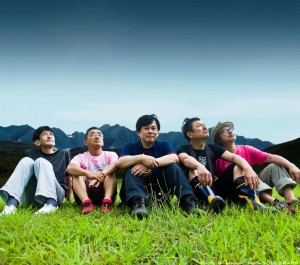
- Hikashu headlines New York’s Japan Society May 13 with Tomoe Shinohara and Steve Eto. (Ikeda Masaaki & Makigami Koichi)
By JQ magazine editor Justin Tedaldi (CIR Kobe-shi, 2001-02) for Examiner.com. Visit his page here to subscribe for free alerts on newly published stories.
This Friday (May 13), Japan Society’s Performing Arts Season goes into overdrive with Hikashu and Tomoe Shinohara Live in Concert, a special one-night-only event featuring the North American debut of legendary band Hikashu with special guests Tomoe Shinohara and Steve Eto.
Drawing on more than thirty years in the music business, Hikashu combines J-pop, new wave and electronic pop, taking listeners on unparalleled musical journeys through its signature sound. Led by its founder, enigmatic vocalist Makigami Koichi (vocal, theremin, cornet), the group’s members include Mita Freeman (guitar, sampler), Sakaide Masami (bass, electronics), Shimizu Kazuto (piano, synthesizer, bass-clarinet) and Sato Masaharu (drums, voice). Currently a lecturer at Shizuoka University of Art and Culture, Koichi has performed at Japan Society twice before as part of the New Voices from Japan series curated by John Zorn (2006) and Ikue Mori: Celebrating 30 Years of Live, Love & Music in NYC also curated by Zorn (2008).
Joining headliners Hikashu at the Manhattan venue is singer, actress and Japanese pop culture icon Tomoe Shinohara with percussionist Steve Eto. Best known to anime fans in the West for singing “Ultra Relax,” the title song of Kodomo no Omocha (released as Kodocha in North America), Shinohara is a choice stylistic counterpoint to the sounds on display. As a musician, songwriter and lyricist, Shinohara (or Shinorer, as her Japanese fans affectionately call her) has released a score of albums, featuring guest spots from artists as diverse as Pizzicato Five, Cibo Matto and Julio Iglesias(!).
For the rest of the story, click here.
Sankei Shimbun article about Taylor Anderson
Thanks to JETAA Music City President Terry Vo for sharing this an very moving article (in Japanese) written by Yoshihisa Komori about Taylor Anderson. Komori-san went to visit Taylor’s parents for the interview.
Update 05/10/11: Thanks to Jo McCarthy (Shimane-ken, Okuizumo-cho) of the JET Alum Translators/Interpreters group on LinkedIn for providing an English translation.
“The death of a woman who loved Ishinomaki”
by Yoshihisa Komori; translated by Jo McCarthy (Shimane-ken, Okuizumo-cho)
http://sankei.jp.msn.com/world/news/110504/amr11050402570003-n1.htm
I was immediately reminded of the old film “Gone With The Wind.”
This was because the large mansion I arrived at after leaving the extensive lush green woods had white pillars and a porch, which rose elegantly in the traditional style of the southern United States. At the rear of the residence, the green gently sloping gardens extended as far as the James River.
Why, I wondered, would a young American woman who grew up in an environment such as this, be fascinated by the town of Umibe in the Tohoku region of Japan?
This was the house of the parents of Taylor Anderson – the English teacher who was caught in a tsunami in Ishinomaki City, Miyagi Prefecture, following the Great East Japan Earthquake of March 11, and died.
It’s in the quiet hills on the outskirts of Richmond, capital of the state of Virginia.
In the spacious living room Taylor’s father Andy, who manages a real estate company, and her mother Jean, a housewife, (both 53) spoke quietly of their thoughts about their eldest daughter, who was 24 years old.
“Taylor learned Japanese history at elementary and junior high school from the same teacher, and became fascinated by Japan. Her teacher was an American, but they had been brought up in Japan, so also taught our daughter Japanese language and culture. It became our daughter’s dream to live and study in Japan.”
“Taylor liked Japanese anime and the novels of Haruki Murakami,” Andy adds to Jean’s explanation. “She seemed to love the elegance and subtleness of Japanese culture. And also often said she really liked the settled order and politeness, a unique character of Japanese society.”
Soon after graduating university, Taylor applied for and was accepted on the JET Program (a program open to foreign youth), and in the summer of 2008 moved to Ishinomaki. She taught English at 7 elementary schools in Ishinomaki, and the story of how she was loved by her students has even been reported in detail in this newspaper.
On the day of the earthquake, after ensuring that her students had been picked up by their caregivers, Taylor was heading home as usual on her bicycle.
However, Taylor went missing.
Her parents desperately made contact with a number of people in Japan. They heard she had been reported as having been found safe, but were unable to confirm it. Andy decided to go and search for Taylor with her boyfriend James.
On the day of their departure, March 21, about 2 hours before they planned to leave for the airport, they received news from the US Embassy in Tokyo that her body had been positively identified.
“It feels as though Taylor’s death has opened a hole in our hearts. But she would not want that for her parents. She was a person who always looked positively to the future, and made things enjoyable just by being there”.
As the first tears began to fall, Jean told how Taylor had planned to return to the US in August this year to get engaged to James, and to either start postgraduate study or look for Japan related work.
Well then, wouldn’t it have been better if she had ended her time in Japan after 2 years, and returned home last year?
However, Jean promptly replied “No. I visited Ishinomaki myself for about 5 days in spring last year, and was able to understand completely why my daughter wanted to be there long term. She was happy doing what she most wanted to do.”
The Andersons, in collaboration with their daughter’s alma mater St. Catherine’s High School, have started a foundation named the Taylor Anderson Memorial Fund. So far, around $90,000 has been raised.
In accordance with Taylor’s wishes, all proceeds from the fund will be directed toward the restoration of Ishinomaki City’s elementary and junior high schools.
See below for the foundation’s website.
Translated by Jo McCarthy
【朝刊 1面】 ■【あめりかノート】ワシントン駐在編集特別委員・古森義久
■石巻を愛した女性の死
古い映画の「風と共に去りぬ」を一瞬、連想した。緑豊かな広大な林を抜けて着いた大邸宅
にはいかにもアメリカ南部ふうの伝統的な白い円柱とポーチが優雅にそびえていたからだ。邸宅の裏には緑の庭がジェームズ川の岸までなだらかに延びていた。こんな環境で育った若い米国人女性がなぜ日本の東北の海辺町に魅せられたのかと、いぶかった。
東日本大震災の3月11日、宮城県石巻市で津波に巻き込まれて亡くなった英語教師の
テー ラー・アンダーソンさんの両親が住む家だった。バージニア州の州都リッチモンド郊外の閑静な丘陵である。 不動産会社を経営する父親のアンディさん、専業 主婦の母親のジーンさんはともに53歳、ゆったりとした居間で24歳だった長女、テーラーさんへの思いを穏やかに語った。
「テーラーは小中学校で同じ先生から日本の歴史を学び、日本に魅せられたのです。そ
の先生はアメリカ人ですが、日本で育ち、日本の言葉や文化までを娘に教えてくれました。日本に住んで学ぶことが娘の夢となったのです」
ジーンさんのこんな説明にアンディさんがつけ加える。
「テーラーは日本のアニメや村上春
樹の小説が好きでした。日本の文化の優雅さや繊細さを愛したようです。そして一定の秩序や礼節という日本社会の特徴も大好きだとよく話していました」
テーラーさんは大学卒業後すぐに日本のJETプログラム(外国青年招致事業)に応募して
採用され、2008年夏に石巻に赴任した。石巻では小中学校計7校で英語を教え、生徒たちに愛されていた様子は本紙でも会田聡記者が詳しく報じた。大震災の日も彼女は生徒たちが保護者に引き取られるのを見届けてから、自転車で自宅へ向かったという。
だがテーラーさんは行方不明になった。両親は米国から必死で日本の多方面に問い合わせ
た。 無事でみつかったという情報も流れたが、確認できなかった。アンディさんはテーラーさんの恋人のジェームズさんと捜索に出かけることを決めた。その出発の 日の3月21日、空港へ向かう予定の2時間ほど前に東京の米国大使館からテーラーさんの遺体が確認されたという通報があった。
「テーラーの死で私たちの心は穴があいた感じです。でも彼女自身は両親にそんなことは
望まない。彼女は前向きで明るく、ともにいるだけでこちらが楽しくなる子でした」
ジーンさんは初めて涙をにじませ、テーラーさんが今年8月には米国に帰り、ジェームズさ
んと婚約し、大学院か日本関係の職業を目指すことを決めていたのだと告げた。では日本滞在を2年ですませ、昨年帰国してもよかったのではないか。
だがジーンさんは即座に答えた。 「いいえ、私自身、昨年春に石巻を5日ほど訪れ、娘が
なぜそこに長くいたいか体全体で理解できました。自分が最もしたいことをしていた彼女は幸せだったのです」
アンダーソン夫妻は娘の母校セント・キャサリン高校と協力して「テーラー・アンダーソン追
悼基金」という募金を始めた。これまでに9万ドルほどが集まった。基金は故人の遺志を体してすべて石巻市の小中学校の復旧に充てる。同基金のサイトは以下だという。



